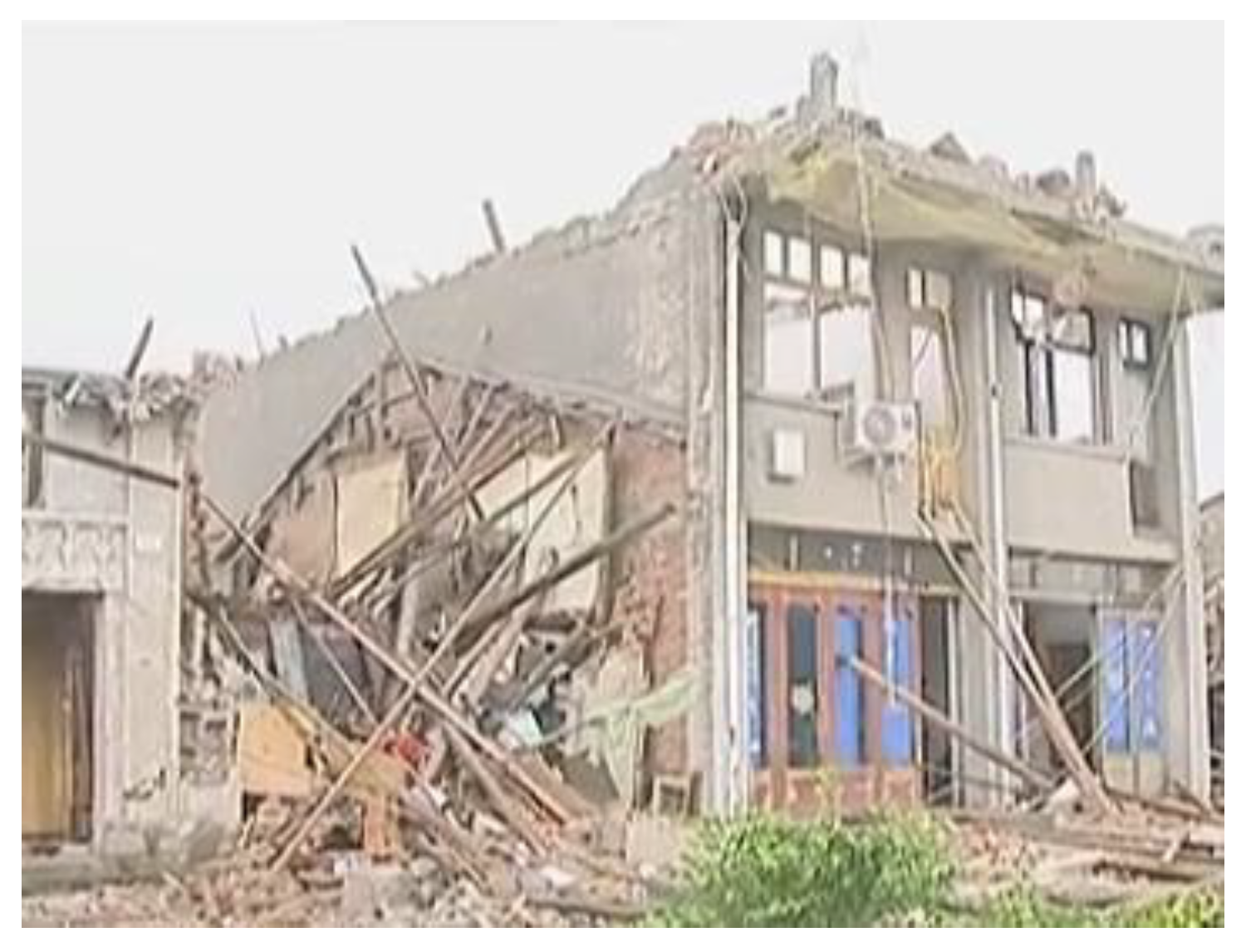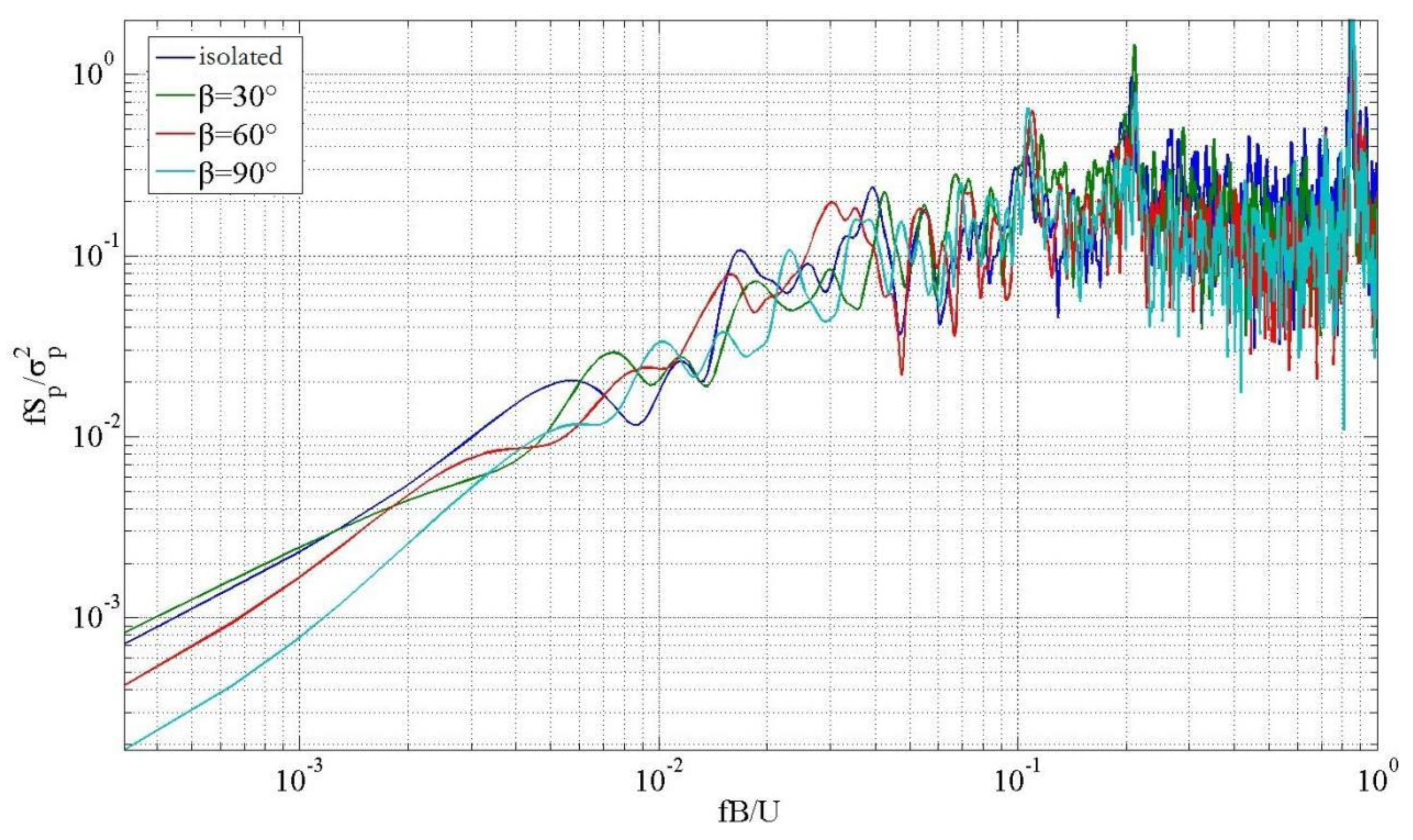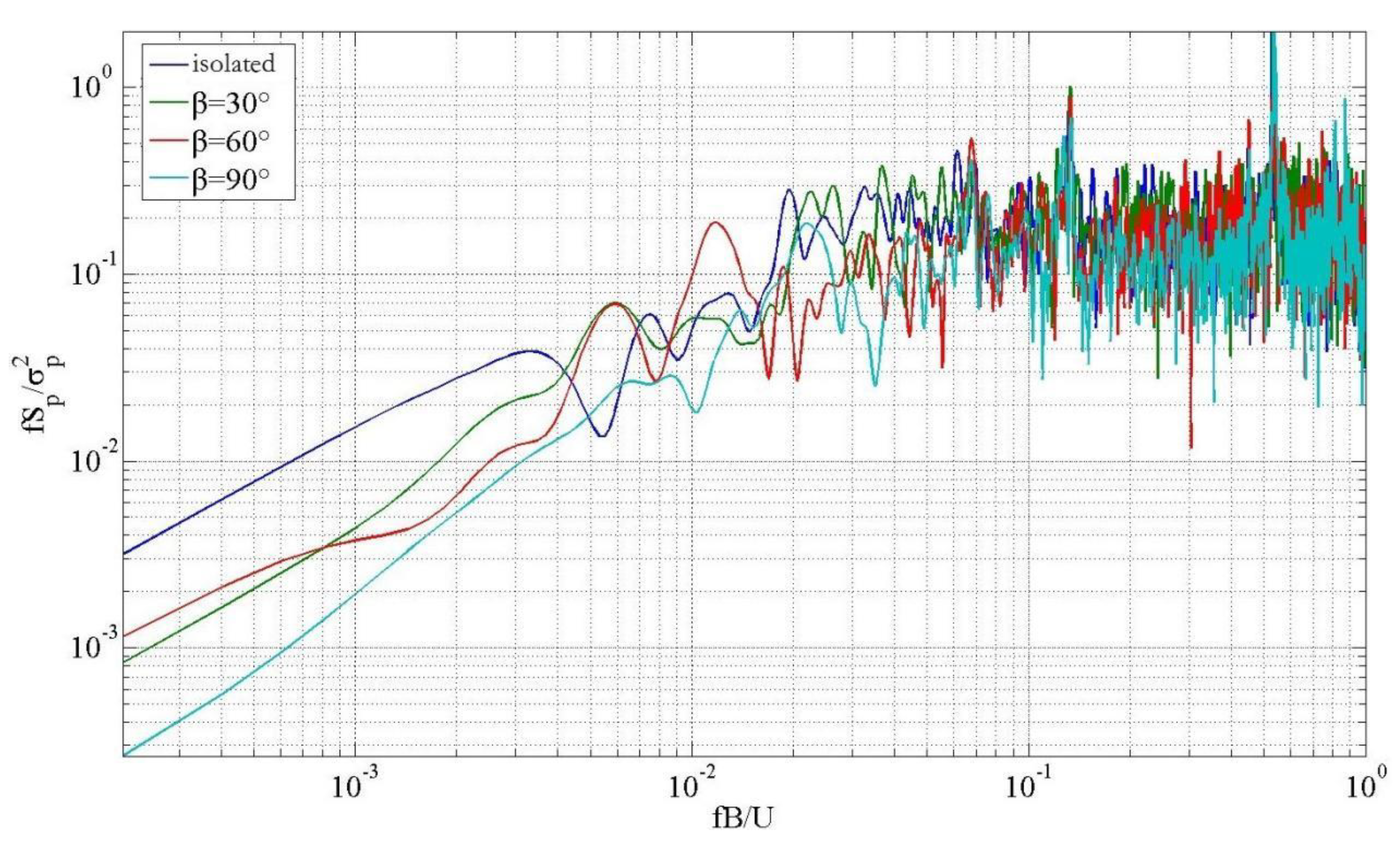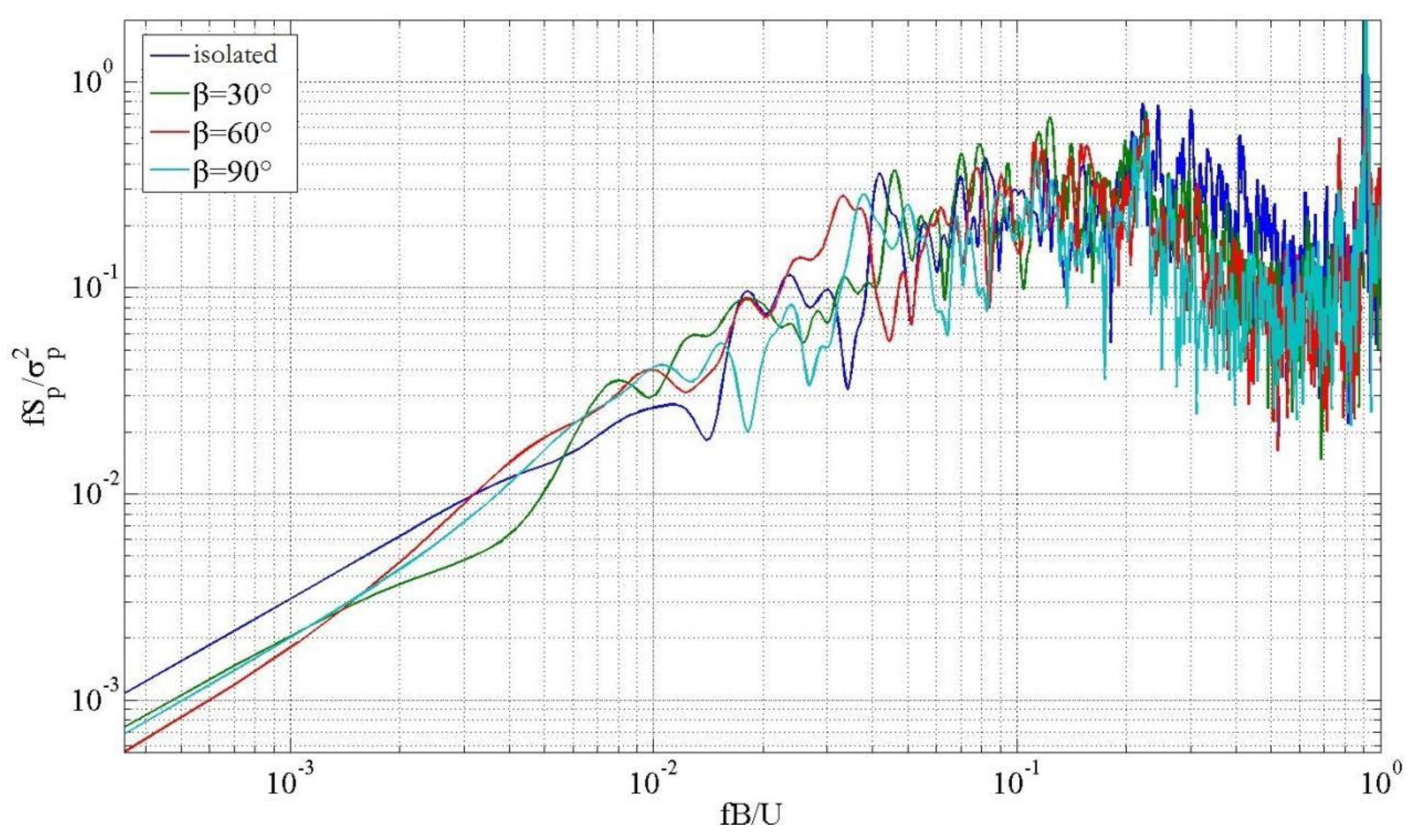Study on Probabilistic Properties of Fluctuating Wind Pressure Distribution of Low-Rise Buildings Affected by Slope Gradient in Mountain Forms
Abstract
1. Introduction
2. Wind Tunnel Tests Experiments
2.1. Physical on Scale Model
2.2. Experimental Operating Condition
2.3. Simulation Test of Wind Field
2.4. Data Analysis Method
Local Mean Pressure Coefficient
3. Study on the Disturbance Effect of Fluctuating Wind Pressure Coefficient with Slope Gradient
3.1. Analysis on the Variation of Fluctuating Wind Pressure Coefficient with Slope Gradient
3.2. Analysis of the Influence of Mountain Form Slope Gradient on Fluctuating Wind Pressure Coefficient under Different Wind Angles
3.3. Analysis on the Isoline of Disturbance Factors of Fluctuating Wind Pressure Coefficient Varying with Slope Gradient
4. Comparative Analysis on the Power Spectra of Representative Measuring Points with Slope Gradient
5. Analysis of the Probability of Fluctuating Wind Pressure of Low-Rise Buildings with Slope Gradient
6. Conclusions
- (1)
- The representative measurement points were observed for power spectrum variation with relevant parameters under 0° wind angle, and the results showed that the energy in the low-frequency band decreased, but it increased as the high-frequency band increased under a mountain form compared with the conditions without the influence of the surrounding environment. This discrepancy may be due to the presence of a mountain body that inhibited the spatial large-scale vortex structure, weakened the turbulence of the incoming wind, and strengthened the small-scale vortex. At the windward eaves, with the increase of slope gradient, the energy in the low-frequency band dropped, but it surged in the high-frequency band.
- (2)
- An analysis of the variation law of wind pressure probability distribution of middle measuring points in different areas at 0° wind angle showed that with the increase of the slope gradient, the wind pressure probability density distribution map gradually changes from symmetric to asymmetric at the measuring points of windward eaves and side centers, which show that the wind pressure probability density distribution changes from non-Gaussian to Gaussian. Furthermore, the lee side middle measuring points had a Gaussian wind pressure distribution under all of the four working conditions.
- (3)
- Compared with no surrounding environment, the energy in the low frequency band is weakened and the energy in the high frequency band is enhanced when there are mountains. This is mainly due to the existence of mountains, which restrain the large-scale vortex structures in space, weaken the turbulence characteristics of incoming wind and increase the small-scale vortex.
- (4)
- Among them, the non-Gauss of the roof measuring points WA7 and WA20 is more obvious, and it is mainly because these measuring points are located in the airflow separation area at the front of the roof, and the pulsating energy of the pressure is not only affected by the turbulence degree of the incoming flow itself, but also mainly from the characteristic turbulence caused by the separation of the airflow. Due to the presence of longer negative pressure tails, it has a higher probability of high negative pressure than the Gaussian distribution. The probability distribution of wind pressure at other measurement points is very consistent with the Gaussian distribution, mainly because these measurement points are not in the airflow separation zone, and the pulsating energy of the wind pressure mainly comes from the contribution of the turbulence degree of the airflow itself. The non-Gaussian characteristics of the wind pressure probability distribution at the measuring points on the structure surface are mainly caused by the effects of air separation, vortex shedding and vortex reattachment.
Author Contributions
Funding
Data Availability Statement
Conflicts of Interest
References
- Dai, Y.M.; Li, Z.N. Wind loads on low-rise buildings: Study on variation of near ground wind profiles. Chin. Civ. Eng. J. 2009, 42, 42–48. [Google Scholar]
- Alrawashdeh, H.; Stathopoulos, T. Wind pressures on large roofs of low buildings and wind codes and standards. J. Wind Eng. Ind. Aerodyn 2015, 147, 212–225. [Google Scholar] [CrossRef]
- Chen, B.; Cheng, H. Interference effects on wind loads of gable-roof buildings with different roof slopes. J. Wind. Eng. Ind. Aerodyn. 2019, 189, 198–217. [Google Scholar] [CrossRef]
- Kwan, K.; Kopp, G.A. The effects of edge radius on wind tunnel tests of low-rise buildings. J. Wind Engin. Indust. Aerodynam. 2021, 214, 104668. [Google Scholar] [CrossRef]
- Chahardoli, S.; Khakzand, M.; Faizi, M.; Siavashi, M. Numerical analysis of the effect of roof types and porch on particle dispersion and deposition around a low-rise building. J. Build. Eng. 2022, 53, 104–125. [Google Scholar] [CrossRef]
- Liu, Z.X.; Yu, Z.X. An investigation on external airflow around low-rise building with various roof types: PIV measurements and LES simulations. Build. Environ. 2020, 169, 104533. [Google Scholar] [CrossRef]
- Pindado, S.; Meseguer, J.; Franchini, S. Influence of an upstream building on the wind-induced mean suction on the flat roof of a low-rise building. J. Wind Eng. Ind. Aerodyn. 2011, 99, 889–893. [Google Scholar] [CrossRef]
- Kim, Y.C.; Tamura, Y. Shielding effects on wind force correlations and quasi-static wind load combinations for low-rise building in large group. J. Wind. Eng. Ind. Aerodyn. 2013, 112, 58–70. [Google Scholar] [CrossRef]
- Li, G.; Gan, S.; Li, Y.; Wang, L. Wind-induced interference effects on low-rise buildings with gable roof. J. Wind Eng. Ind. Aerodyn. 2017, 170, 94–106. [Google Scholar] [CrossRef]
- Li, Z.; Li, Y.X. The influence of muti/high-rise building on the surface wind load of low-rise building. Alex. Eng. J. 2022, 61, 11979–11991. [Google Scholar]
- Kim, Y.C.; Tamura, Y.k. Proximity effect on low-rise building surrounded by similar-sized buildings. J. Wind. Eng. Ind. Aerodyn. 2015, 146, 150–162. [Google Scholar] [CrossRef]
- Meddage, D.P.P.; Lewangamage, C.S. On the deviation of mean pressure coefficients in wind loading standards for a low-rise, gable-roofed building with boundary walls. Structures 2022, 36, 50–64. [Google Scholar]
- Alok, D.J.; Gaurv, S. Interference Effect on Wind Loads on Gable Roof Building. Procedia Eng. 2011, 14, 1776–1783. [Google Scholar]
- Yong, C.K.; Akihito, Y.; Yukio, T. Characteristics of surface wind pressures on low-rise building located among large group of surrounding buildings. Eng. Struct. 2012, 35, 18–28. [Google Scholar]
- Chen, B.; Luyu, J.; Kun, D. Interference Effects of Wind Loads of Two Low-rise Building with Flat Roof. In Proceedings of the 14th International Conference on Wind Engineering, Porto Alegre, Brazil, 21–26 June 2015; pp. 21–26. [Google Scholar]
- Li, G.; Gan, S.; Li, Y.; Wang, L. A study on the wind-induced disturbance effect of low-rise buildings. Coll. Disaster Prev. Mitig. Eng. 2017, 36, 1023–1029. [Google Scholar]
- Li, Y.X. A study on the Wind-Induced Disturbance Effect of Gable Roof Low-Rise Buildings. Doctoral Dissertation, Dalian University of Technology, Dalian, China, 2016. [Google Scholar]
- Tang, M. A Study on the Wind Load Disturbance Effect of Groups of Low-Rise Buildings. Doctoral Dissertation, Dalian University of Technology, Dalian, China, 2019. [Google Scholar]
- Weng, W.; Taylor, E.A.; Walmsley, J.L. Guidelines for air flow over complex terrain: Model developments. J. Wind. Eng. Ind. Aerodyn. 2000, 86, 169–186. [Google Scholar] [CrossRef]
- Shi, L.L. Analysis of Wind Load Effect of the Low-rise Housing in the Complicated Mountain Terrain. Doctoral Dissertation, Huaqiao University, Quanzhou, China, 2009. [Google Scholar]
- Zhong, M.; Li, Z.N.; Min, Q. Wind tunnel test on wind load of low-rise buildings in typical mountain landform:analysis of hillside slope effects. Acta Aerodyn. Sin. 2016, 34, 687–695. [Google Scholar]
- Li, Z.N.; Zhong, M.; Lamei, H.U. Wind tunnel test on low-rise buildings influenced by spacing between hillside and building in typical mountain terrain. J. Build. Struct. 2015, 36, 67–74. [Google Scholar]
- Wei, Q.X. Study on Estimation of Extreme Wind Pressure and Interference Effect of Typical Low Houses with Double Slopes. Doctoral Dissertation, Guangzhou University, Guangzhou, China, 2020. [Google Scholar]
- Wang, X.J.; Li, Q.S. Nonstationary near-ground wind characteristics and wind-induced pressures on the roof of a low-rise building during a typhoon. J. Build. Eng. 2022, 53, 1–22. [Google Scholar] [CrossRef]
- Ministry of Housing and Urban Rural Development of the People’s Republic of China. Load Code for Building Structures (GB50009-2012); China Construction Industry Press: Beijing, China, 2006; pp. 33–34. [Google Scholar]
- Kumar, K.S.; Stathopoulos, T. Power spectra of wind pressure on low building roofs. J. Wind Eng. Ind. Aerodyn. 1998, 74–76, 665–674. [Google Scholar] [CrossRef]
- Kumar, K.S.; Stathopoulos, T. Wind loads on low building roofs: A stochastic perspective. J. Struct. Eng. 2000, 126, 944–956. [Google Scholar] [CrossRef]
- Qiu, T.S. Statistical Signal Processing Non-Gaussian Signal Processing and Its Application; Electronic Industry Press: Beijing, China, 2005; pp. 45–49. [Google Scholar]
- Yue, W. Study on Wind Effect and Wind Resistance Design Theory of Long-Span Roof Structures. Postdoctoral Dissertation, Tongji University, Shanghai, China, 2006. [Google Scholar]
- Sun, Y. Characterisitics of Wind Loading on Long-Span Roofs. Doctoral Dissertation, Harbin University of Technology, Harbin, China, 2007. [Google Scholar]
- Peng, X.; Yang, L.; Gavanski, E. A comparison of methods to estimate peak wind loads on buildings. J. Wind. Eng. Ind. Aerodyn. 2014, 126, 11–23. [Google Scholar] [CrossRef]
- Holmes, J.D. Non-Gaussian characteristics of wind pressure fluctuations. J. Wind Eng. Ind. Aerodyn. 1981, 7, 103–108. [Google Scholar] [CrossRef]
- Li, Q.S. Probability characteristics of pressure fluctuations in separated and reattaching flows for various free-stream turbulence. J. Wind Eng. Ind. Aerodyn. 1999, 82, 125–145. [Google Scholar] [CrossRef]
- Uematsu, Y. Peak gust pressure acting on the roof and wall edges of a low-rise building. J. Wind Eng. Ind. Aerodyn. 1998, 77, 217–231. [Google Scholar] [CrossRef]
































| Model dimensions | Plan dimensions | 111.25 mm (width) × 187.5 mm (length) |
| Eave height | 148.75 mm | |
| Roof height | 170.75 mm | |
| Roof slope | 18.6° | |
| Position of mountain | Distance between mountain and model | 68.3 mm (S/H = 0.4) |
| β | 30° 60° 90° | |
| Terrain roughness, z0 | 0.12 | |
| Wind angles | 0°~90° (5° increments) | |
| Number of taps | 374 | |
| Sampling frequency | 312.5 Hz | |
| Wind tunnel speed | 12 m/s | |
| Model length scale | 1:40 | |
| Working Condition | β (°) | H (mm) | S (mm) | Hm (mm) |
|---|---|---|---|---|
| 1 | 30 | 170.75 | S/H = 0.4 | Hm/H = 2 |
| 2 | 60 | 170.75 | S/H = 0.4 | Hm/H = 2 |
| 3 | 90 | 170.75 | S/H = 0.4 | Hm/H = 2 |
| Without the surrounding | - | - | - | - |
Publisher’s Note: MDPI stays neutral with regard to jurisdictional claims in published maps and institutional affiliations. |
© 2022 by the authors. Licensee MDPI, Basel, Switzerland. This article is an open access article distributed under the terms and conditions of the Creative Commons Attribution (CC BY) license (https://creativecommons.org/licenses/by/4.0/).
Share and Cite
Zhong, M.; Huang, B.; Li, Z.; Zhou, Z.; Liu, Z. Study on Probabilistic Properties of Fluctuating Wind Pressure Distribution of Low-Rise Buildings Affected by Slope Gradient in Mountain Forms. Symmetry 2022, 14, 2513. https://doi.org/10.3390/sym14122513
Zhong M, Huang B, Li Z, Zhou Z, Liu Z. Study on Probabilistic Properties of Fluctuating Wind Pressure Distribution of Low-Rise Buildings Affected by Slope Gradient in Mountain Forms. Symmetry. 2022; 14(12):2513. https://doi.org/10.3390/sym14122513
Chicago/Turabian StyleZhong, Min, Bin Huang, Zhengnong Li, Zhanxue Zhou, and Zhongyang Liu. 2022. "Study on Probabilistic Properties of Fluctuating Wind Pressure Distribution of Low-Rise Buildings Affected by Slope Gradient in Mountain Forms" Symmetry 14, no. 12: 2513. https://doi.org/10.3390/sym14122513
APA StyleZhong, M., Huang, B., Li, Z., Zhou, Z., & Liu, Z. (2022). Study on Probabilistic Properties of Fluctuating Wind Pressure Distribution of Low-Rise Buildings Affected by Slope Gradient in Mountain Forms. Symmetry, 14(12), 2513. https://doi.org/10.3390/sym14122513








